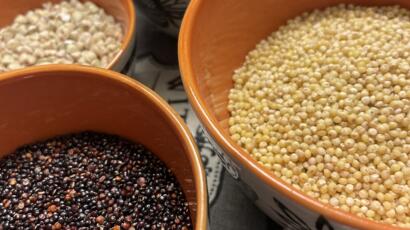
While I was studying to become an integrative nutrition health coach through Institute for Integrative Nutrition, they dedicated an entire module to information about gluten and gluten-free alternatives. In this post, I will share some of the knowledge I have gleaned from my education, as well my personal experience. I will cover the symptoms one may experience when one may have a gluten sensitivity, tips for choosing gluten-free alternatives, and my personal experience of going gluten-free.
So, what are some of the symptoms of gluten intolerance or gluten sensitivity? It’s not a very attractive list. Symptoms include diarrhea (especially if it happens often for no apparent reason), abdominal pain, gas, bloating, skin rashes, and even depression. Yes, depression. Did you know that a large amount of serotonin is produced in your gut? I didn’t believe it either until I did further research, but that’s a topic for another blog. Furthermore, Dr. Mark Hyman,M.D. even went on to state that “gluten is linked to many psychiatric and neurological diseases, including anxiety, schizophrenia, dementia, migraines, epilepsy, and autism.” That’s quite a list. I’ve tried to include everything that would be obvious, like bloating and diarrhea, and less obvious, sneaky side effects of eating gluten, like depression and anxiety. I focus on this because I’ve shared in previous blog posts how I experience these symptoms in my everyday life.
The best way to see if you’re sensitive to gluten is to stop eating it. This may be devastating news. No pasta, bread, or many processed foods ever again? What will you eat?! How will you live?! Take a deep breath, my friend. I am here to hold your hand and guide you to a path that will help improve your health and allow you to start feeling like your old self. With that said, you should always check in with your healthcare provider before making major changes in your diet. Often they won’t mind, but it’s a good idea to give them a heads up.
So what can you eat on a gluten-free diet? I’m so glad you asked! We are so fortunate to live in a time where we have many gluten-free options at the grocery store. There are also many grains that are naturally gluten-free. Gluten is the protein found in wheat and it is what gives bread the chewy texture that we so often enjoy. It’s also found in wheat germ, bulgur, rye, and barley. When you are going gluten-free, it is best to avoid these products; make sure to check ingredients in any processed foods before you purchase them. Oats are often processed in the same facilities as gluten products and can cause you to feel unwell if you have a more serious gluten allergy or celiac disease.
That’s the list of foods to avoid, now let me introduce you to the list of delicious foods you CAN have. Obviously, any product labeled gluten-free, such as Ezikel breads and tortillas or Bob’s Red Mill 1 to 1 gluten-free flour. I also love Namaste gluten-free flour, but I have only been able to find it on Amazon. There are also many different varieties of gluten-free pastas, such as chickpea, red lentil, or black bean pasta. I love the Tinkyada brand, it is very similar to wheat pastas and it doesn’t get mushy like some other brands. I also mentioned that many grains are naturally gluten-free. These grains include brown rice, amaranth, corn, buckwheat, teff, quinoa, and millet. There are so many great options available that you will never feel deprived. It’s also important to note that fruits (like avocados and bananas), vegetables (like kale and sweet potatoes), seeds (like sunflower and pumpkin), beans (like adzuki and pinto), and nuts (like almonds and pecans) are all gluten-free. When you look at how much you can have versus how much you’re giving up (as well as those awful symptoms), it seems like less of a loss and more of a victory.
I often swing back and forth between a macrobiotic diet, usually in the fall and winter, and a raw foods diet in the spring and summer. I’ve learned many recipes over the course of my life and I have found that when I prepare foods that are gluten-free, I feel my best. When I eat gluten, I feel nauseated and I have brain fog. It usually impacts me most the next day. Often, I make something easy for dinner, usually “normal” spaghetti at the request of my husband and son, and I feel awful the next morning; almost like a hangover. I hate it, but it’s my reminder that gluten is not my friend. This is my personal experience and it doesn’t mean that you can’t thrive on gluten. However, if you are experiencing any of the symptoms we talked about earlier, I would strongly encourage you to get curious about a gluten-free diet.
If you feel like this is something you want to pursue, but you’re feeling a little nervous about doing it alone, please don’t hesitate to contact me. I love helping people find a diet that works best for them and I have years of experience to help guide you along the path meant for you. I offer a free 50 minute consultation where we can talk about the goals you want to achieve or diets you want to explore. Head over to my contact page and send me an email or go straight to the consultation page and schedule an appointment with me.I can’t wait to hear from you!
Love and Rice,
Savannah

